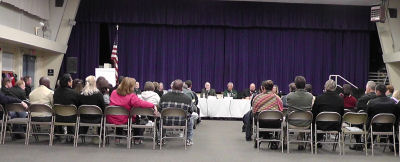
By Jake Christie
February 13, 2013 (La Mesa)—At its March meeting, La Mesa’s City Council will take up issues raised by residents in a pair of community meetings last month. This is a tradition that has gone on for five years.
Council members listened to the questions, complaints, and comments of concerned citizens at the meetings held January 15 and 17 in auditoriums at Lemon Avenue Elementary School and the La Mesa Middle School, where the crowds were standing-room -only at times.
The first meeting began five minutes late, and after a few introductory words, the Council began hearing from the public. Chuck Miller was the first to speak, asking why the corner of Jackson Drive and Grossmont Boulevard (where the Interstate 8 off-ramp dumps cars into La Mesa and where there is a closed-off right turn lane) had not been made more beautiful in the last 30 years or at least contain a “Welcome to La Mesa” sign. Greg Humora, City Engineer, answered, saying that La Mesa would have to work with Caltrans because some of the land is old Caltrans right-of-way, and that the land would either have to be made private or sold to the city, though the La Mesa Church of Christ next to the property was looking to expand. As for the sign, the funding was not there because the city was slowly replacing its wooden welcome signs.
“We did all those [wooden] signs in house, in the ‘80s for $69, 000,” added Councilmember Ernest Ewin. “Today just one of those signs is $25,000. Sometimes it gets more expensive to do certain sorts of things.”
After some citizen comments on the forthcoming 7-11 that will take over the abandoned Shell gas station on Spring Street, the confusing signage University Avenue runs into Baltimore Drive, and the rising cap on sewage rates, Albert Cascia, self-described block captain of Panorama Drive told the city Council that there were wild coyotes wandering around the street, attacking pets and following people. He also pointed out that the Caltrans-owned bridge that carries the 125 freeway has no lights underneath it, and is a magnet for homeless people, graffiti, and illegal garbage dumping.
“The lighting under the overpass is something we are aware,” said La Mesa City Manager David Witt. “The lighting we have tried several times [to get Caltrans to install lights]; we won’t give up. We absolutely agree it’s needed.” According to Greg Humora, he wrote to Caltrans early on as engineer and the agency claimed the bridge didn’t meet the minimum criteria for lights: not enough traffic, bridge is too short, etc. So it is up to the city to find the “resources” to do the job. As for the wild animals, Ed Aceves, the Chief of police, remarked that “CalTrans owns the coyote.” The mayor quickly added that there was one ranger in the state of California that handles coyotes, and that the city would look into contacting that person.
One of the major issues brought up on both evenings was panhandlers; speakers claimed that there were beggars standing on the islands on Baltimore Drive and the corner of Grossmont and La Mesa Boulevards. At the second meeting, a female painter claimed that she saw the homeless busking for change by doing magic tricks; she asked if she could set up her easel on an island and paint the passing cars. The City Council said no. Police Chief Ed Aceves claimed at both meetings that panhandlers make about $100 a day, a figure he did not source. He also claimed that the homeless want to remain on the streets and that his officers take a “zero tolerance” stand on the issue of panhandling, arresting the ones they come across. Vice Mayor Arapostathis claimed that he calls the non- emergency line to report panhandlers when he sees them, while Mayor Madrid recommended not giving them money.
The second meeting at La Mesa Middle School brought a slightly smaller audience and similar complaints: traffic, the convenience stores, questions on using of recycled tap water (the city doesn’t – yet), as well as the fate of the Spring House and the exteriors in the La Mesa Village historical district.
The traffic concerns were about alleged unpainted speed bumps, people stealing the traffic sign where Corona becomes Lime Street, and trolley guardrails coming down too fast. On the convenience stores, a resident of Dallas Street was unhappy at the expansion of 7-11 into La Mesa because of the “2 a.m. robberies” and the “unsavory elements” that hang around the 7-11 as well as the 24 hour taco and doughnut shops. Police Chief Aceves blamed post-release offenders, adding that there are 2300 on the streets because property crimes are considered “low level” offenses. Finally, two residents spoke up for the La Mesa Spring House in Collier Park. Jim Newland and Rod Whitlow pointed out the significance of the building constructed in 1907 as a bottling plant for local spring water by David Charles Collier, who leased the park land to the city when it incorporated in 1911. Newland called the building “really significant” while Whitlow claimed that if the Spring House had not been constructed, La Mesa would not exist where it presently sits.
“We need to save it,” Whitlow finished.
Resident Carol Lockwood wanted to form a historical district in the La Mesa Village to preserve facades of various older buildings. City Manager David Witt replied that La Mesa was going to update the city’s general plan and that pushing for a historical district in the Village would be a good idea.













Recent comments